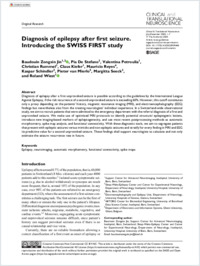Diagnosis of epilepsy after first seizure. Introducing the SWISS FIRST study
- Jin, Baudouin Zongxin ORCID Sleep-Wake-Epilepsy Center and Center for Experimental Neurology, Department of Neurology, Inselspital, University Hospital, University of Bern, Bern, Switzerland
- De Stefano, Pia Electroencephalography and Epilepsy Unit, Department of Neurology, University Hospitals of Geneva, Geneva, Switzerland
- Petroulia, Valentina Support Center for Advanced Neuroimaging, Inselspital, University of Bern, Bern, Switzerland
- Rummel, Christian Support Center for Advanced Neuroimaging, Inselspital, University of Bern, Bern, Switzerland
- Kiefer, Claus Support Center for Advanced Neuroimaging, Inselspital, University of Bern, Bern, Switzerland
- Reyes, Mauricio ARTORG Center for Biomedical Engineering, University of Bern/Insel Data Science Center, Inselspital, Bern, Switzerland
- Schindler, Kaspar Sleep-Wake-Epilepsy Center and Center for Experimental Neurology, Department of Neurology, Inselspital, University Hospital, University of Bern, Bern, Switzerland
- van Mierlo, Pieter Department of Electronics and Information Systems, Ghent University, Ghent, Belgium
- Seeck, Margitta Electroencephalography and Epilepsy Unit, Department of Neurology, University Hospitals of Geneva, Geneva, Switzerland
- Wiest, Roland ORCID Support Center for Advanced Neuroimaging, Inselspital, University of Bern, Bern, Switzerland
- 2020-7-16
Published in:
- Clinical and Translational Neuroscience. - SAGE Publications. - 2020, vol. 4, no. 2, p. 2514183X2093944
English
Diagnosis of epilepsy after a first unprovoked seizure is possible according to the guidelines by the International League Against Epilepsy, if the risk recurrence of a second unprovoked seizure is exceeding 60%. However, this cutoff constitutes only a proxy depending on the patients’ history, magnetic resonance imaging (MRI), and electroencephalography (EEG) findings but nevertheless also from the treating neurologists’ individual experience. In a Switzerland-wide observational study, we aim to recruit patients that were admitted to the emergency department with the referral diagnosis of a first and unprovoked seizure. We make use of optimized MRI protocols to identify potential structural epileptogenic lesions, introduce new imaging-based markers of epileptogenecity, and use most recent postprocessing methods as automatic morphometry, spike map analysis, and functional connectivity. With these diagnostic tools, we aim to segregate patients that present with epileptic seizures versus mimicks and non-epileptic seizures and stratify for every finding in MRI and EEG its predictive value for a second unprovoked seizure. These findings shall support neurologists to calculate and not only estimate the seizure recurrence rate in future.
- Language
-
- English
- Open access status
- gold
- Identifiers
-
- DOI 10.1177/2514183x20939448
- ISSN 2514-183X
- Persistent URL
- https://folia.unifr.ch/global/documents/263772
Statistics
Document views: 14
File downloads:
- fulltext.pdf: 0
